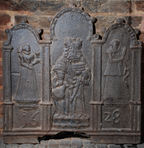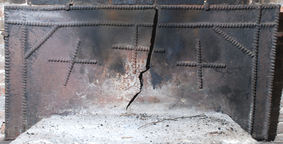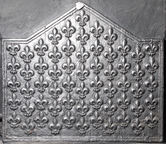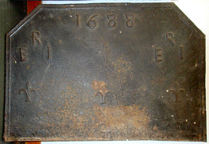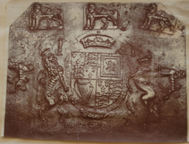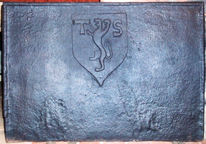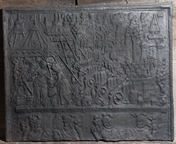-
888
Description: Triple arched rectangular shape, centre arch higher; each arch supported by pilasters; within centre arch, cloaked, bearded male figure wearing a crown and carrying a ewer and what appear to be a pile of plates; in left arch, above first half of date, a clothed female figure carrying a goblet and possibly a candle on a staff; in the right arch, above the second half of the date, a clothed female figure holding a distaff and a length of wool; there is a narrow panel at the bottom; on the outside of the arches are scroll-shaped protusions.
Notes: The shape of this fireback is relatively uncommon, and the significance of the figures may relate to a particular narrative.
Inscription: 16 28
- Decoration tags:
- rectangular with three arches (shape)
- complex individual (edging)
- carved stamps
- whole carved pattern
- individual numbers
- architectural
- text
- humans
Manufactured: in 1628 possibly in the Eifel area of Germany.
Current location: in private hands, Cowden, Kent, England.
- Attached to series:
- Figurine firebacks
-
41
Description: Arched rectangular shape; rope edging (top and sides); Tudor royal shield, garter, crown and supporters (crowned lion and dragon); date above crown; empty motto compartment with initials below.
Notes: Identical arms can be seen on fireback formerly at Baynards Park, Cranleigh (no. 200), and on one in private hands at Maresfield (no. 482), neither of which have the motto compartment; minor variations in the position of individual elements indicate that the garter and shield, crown, and each supporter were separately stamped; the initials are likely to be those of Henry Bowyer, ironmaster (d.1588), the fireback perhaps being made in his memory.
Inscription: 1588 HB
Arms: Tudor royal (Elizabeth I)
- Decoration tags:
- rectangular with round arch (shape)
- rope (edging)
- carved stamps
- individual letters
- individual numbers
- armorial
- royal
- text
- objects
Manufactured: in 1588 possibly at Pounsley Furnace, Framfield in the Weald area of England.
Current location: in private hands, Cuckfield, West Sussex, England.
-
69
Description: Rectangular; twisted rope edging (top and sides); twisted rope lengths parallel to top and both sides and crossing at corners, with shorter rope lengths across inside angles; shorter rope lengths arranged in three crosses across middle of plate, the middle one higher than the other two.
Notes: A particularly large and elaborate arrangement of rope lengths. The crosses suggest Christian significance.
- Decoration tags:
- rectangular (shape)
- rope (edging)
- simple stamps
- apotropaic
- objects
Manufactured: in the 16th century in the Weald area of England.
Current location: in private hands, Freshfield, East Sussex, England.
- Attached to series:
- Rope design firebacks
-
88
Description: Rectangular with triangular arch; stepped fillet edging; eleven columns of fleurs de lys, maximum seven in column, but varied according to space, with fleurs alternated for spacing.
Notes: Whole pattern with five vertical planklines; a field of small fleurs de lys, France Ancient in royal heraldry, might suggest a continental origin.
Copies of this fireback are known.
- Decoration tags:
- rectangular with triangular arch (shape)
- stepped fillet (edging)
- whole carved pattern
- planklines
- heraldic
- objects
Manufactured: in the late-16th to early-17th century possibly in the Weald area of England.
Current location: Hampton Court, Richmond, Greater London, England.
- Attached to series:
- Miscellaneous royal firebacks
- Fleur-de-lys firebacks
-
864
Description: Canted rectangle; double fillet edging (top and sides); top centre, date; initials in triad, repeated on each side, with a fleur-de-lys between; three fleurs-de-lys evenly spaced below initial groups.
Notes: The initials are believed to be those of Edward Robinson, a bookseller, and his wife of 16 King Street, Ludlow, where the fireback was discovered.
Inscription: 1688 / ERI ERI [both triads]
- Decoration tags:
- rectangular with canted top corners (shape)
- double fillet (edging)
- carved stamps
- individual letters
- individual numbers
- heraldic
- text
Manufactured: in 1688 possibly in the Shropshire area of England.
Current location: Ludlow Museum. The Buttercross, Ludlow, Shropshire, England.
(part of the Ludlow Museum museum group)
Citation: Moran, M., 2003, Vernacular Buildings of Shropshire (Almeley, Logaston Press).
- Attached to series:
- Ludlow series
- Miscellaneous stamp firebacks
-
1036
Description: Canted rectangular shape; no edging; lower centre, carved pattern panel of Stuart Royal arms: shield, garter, crown, motto, supporters and initials, RI separated by crown; lion statant guardant stamp repeated five times, three across top, one each side feet to left.
Notes: The impression of the decorative elements is irregular, with the achievement of arms under-pressed and the three lion stamps along the top over-pressed; the distinctive feature of the unicorn's horn in front of the initial R has been seen on a small number of other firebacks. The Stuart arms in the same style are seen on another fireback (no. 406). From a photograph in the J. Starkie Gardner Collection, Victoria & Albert Museum, Archive of Art and Design (AAD/2014/8).
Inscription: I R
Arms: English Stuart royal - James I
- Decoration tags:
- rectangular with canted top corners (shape)
- none (edging)
- carved stamps
- carved pattern panels
- heraldic
- armorial
- royal
- text
- animals
Manufactured: in the early-17th century possibly in the Weald area of England.
Current location: Maidstone Museum, St Faith's Street, Maidstone, Kent, England.
(part of the Maidstone Museum museum group)
-
859
Description: Rectangular; twisted rope edging (to and sides); top centre, shield bearing a lion rampant with two heads, between split initials.
Notes: The heraldic charge of a lion rampant with two heads is rare, the only documented family with which it is associated being that of Mason, of Yorkshire, to whom this shield does not seem to apply.
Inscription: TS
Arms: Not known
- Decoration tags:
- rectangular (shape)
- rope (edging)
- carved stamps
- heraldic
- armorial
- text
Manufactured: in the early-16th century in England.
Current location: not known.
- Attached to series:
- Personal armorial firebacks
-
703
Description: Rectangular; cavetto moulded edging; pictorial scene of the siege of Bethulia, with Judith placing the severed head of Holofernes into the bag held by her maid; in the lower panel are the top parts of four knightly figures.
Notes: The design is after one by the pattern-maker, Philipp Soldan, and derived from a woodcut of an engraving by Israhel van Meckenhem; it illustrates scenes from the Apocryphal book of Judith.
- Decoration tags:
- rectangular (shape)
- cavetto (edging)
- whole carved pattern
- pictorial
- biblical
- humans
Manufactured: in the late-16th century in the Eifel area of Germany.
Current location: Tiverton Castle, Tiverton, Devon, England.
- Attached to series:
- Stoveplates
